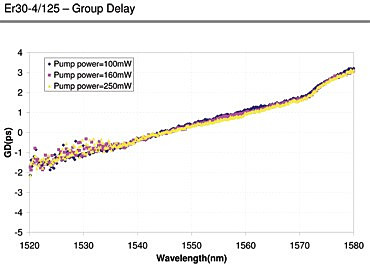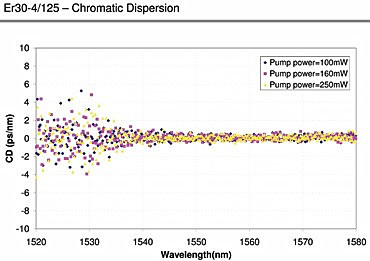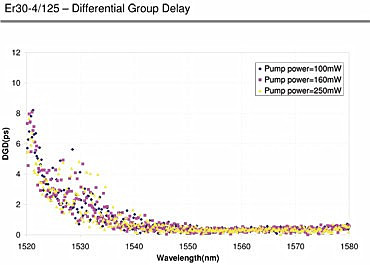- Cart
- |
- Personal Center
- |

ER30-4/125 Erbium-Doped Single-Mode Fiber
High erbium-doped fiber is suitable for fiber lasers and amplifiers operating in the wavelength range of 1530 to 1610 nm (C and L bands). These fibers cover a wide range of applications, from communication amplifiers (erbium-doped fiber amplifiers) to high-power passive optical networks/cable TV boosters, as well as ultra-short pulse amplifiers for instrumentation, industrial, and medical uses. These highly doped fibers feature a standard ?125 μm cladding diameter. Our deep cutoff wavelength erbium-doped fiber offers over 50% conversion efficiency in the L band, equivalent to the conversion effect of 20 meters of conventional fiber
Product features:Optimized for emission wavelengths from 1530 to 1610 nm, with pump wavelengths of 980 nm and 1480 nm 、Geometric properties result in low birefringence and excellent splicing characteristics 、Typical splice loss with pump single-mode fiber is less than 0.1 dB 、Typical splice loss with SMF-28e+ fiber is less than 0.15 dB
Part Number:--
Application area:C- and L-band dense wavelength division multiplexing, Metro, cable TV, and passive optical networks 、Amplified spontaneous emission sources 、Continuous and pulsed lasers and amplifiers
Add to Cart Consult Favorite
Driver Parameters
Product Categories | Doped Fiber |
Fiber Type | EDF40-F |
Peak Absorption at 1532 nm (Max. [1530 – 1535 nm]) Range | 30±3dB/m |
Peak Absorption at 1532 nm (Max. [1530 – 1534 nm]) Typical Value | 36 dB/m |
Peak Absorption Variation Over 250m Fiber Length | ≤2.5 % |
Background Loss (Min. [1100 – 1300 nm]) Maximum Value | ≤ 10 dB/km |
Background Loss (Min. [1100 – 1300 nm]) Typical Value | ≤ 6 dB/km |
Bend Sensitivity (100 m, 15 mm bend radius, λ < 1620 nm) | ≤ 0.1 dB |
Cutoff Wavelength | 890±90nm |
Mode Field Diameter at 1550 nm | 6.5 ± 0.5 μm |
Numerical Aperture | 0.2 |
Splice Loss (with G.652 at 1300 & 1700 nm) | ≤ 0.2 dB |
Polarization Mode Dispersion (100 m) | ≤ 0.25 ps |
Cladding Diameter | 125 ± 1 μm |
Coating Diameter | 250 ±7 μm |
Core/Cladding Concentricity | ≤0.7 μm |
Cladding/Coating Concentricity | ≤ 12.5 μm |
Fiber Strength | 1.5 % (150 KPSI) |
Commercial Segment Length (±5 m) | 250, 500, 1000 m |
Storage Temperature | - 40 °C to +75 °C |
Operating Temperature | - 5 °C to +75 °C |
Storage Humidity (Non-condensing) | 5 % to 95% |
Operating Humidity (Non-condensing) | 5 % to 95 % |
Group delay, dispersion, and differential group delay tests were conducted on the erbium-doped fiber ER30-4/125 (approximately 5 meters long). The results are as follows:
Group Delay
The following are the group delay (GD) versus wavelength function curves for the ER30-4/125 erbium-doped fiber under three different pump powers. Group delay refers to the time required for information in a signal (e.g., a specific point on a modulated wavefront) to travel through the optical path length.

Dispersion
The following are the chromatic dispersion (CD) versus wavelength function curves for the ER30-4/125 erbium-doped fiber under three different pump powers. Dispersion is the local slope of the group delay versus wavelength curve.

Differential Group Delay
The following are the differential group delay (DGD) versus wavelength function curves for the ER30-4/125 erbium-doped fiber under three different pump powers. Differential group delay is defined as the maximum variation in group delay across all polarization states.

--
⇪